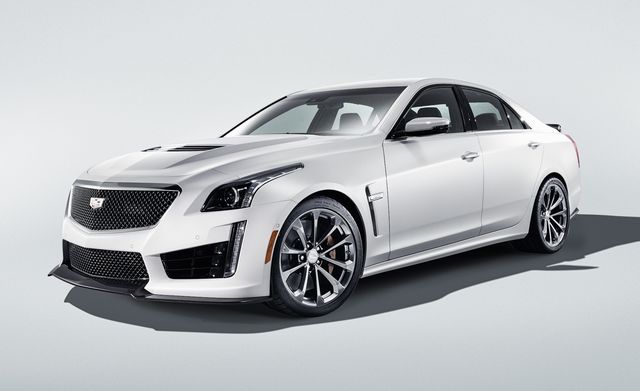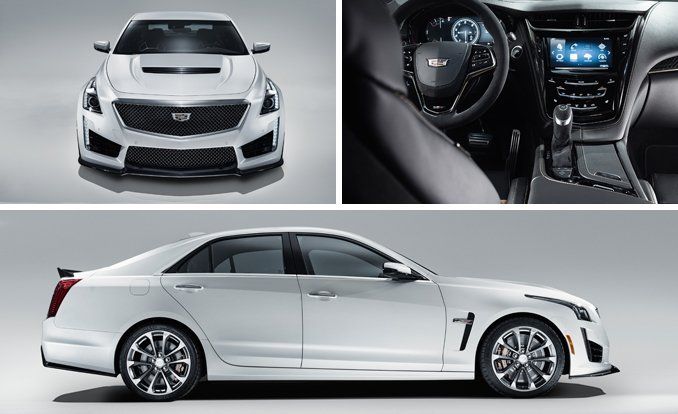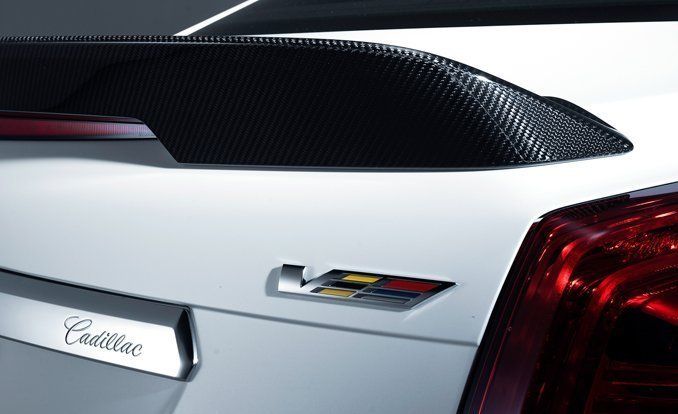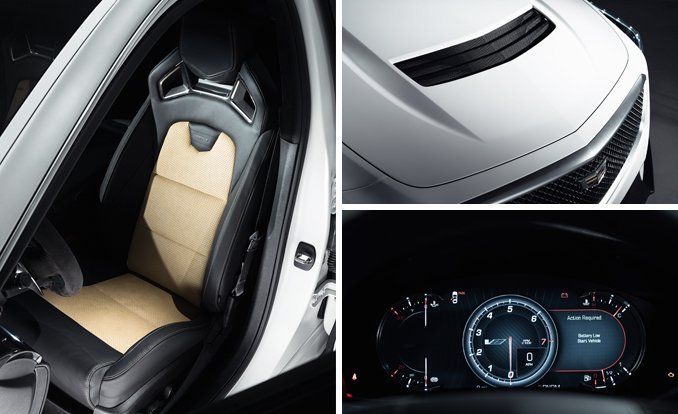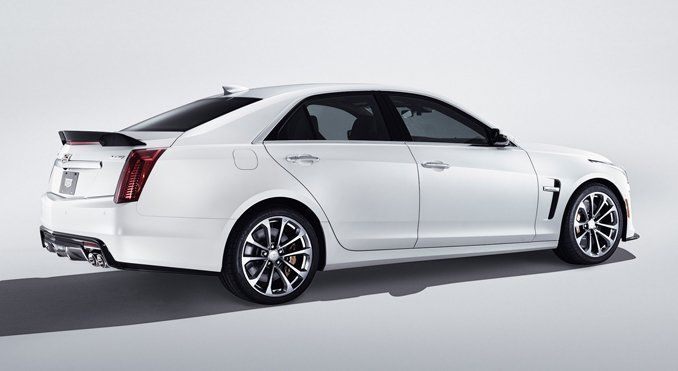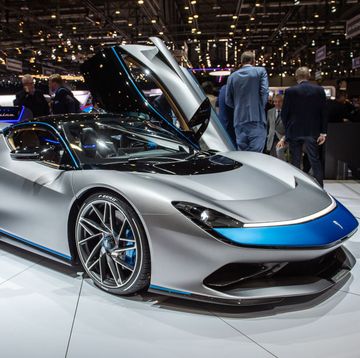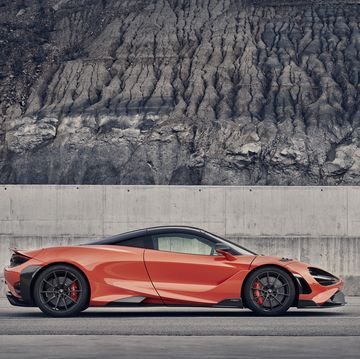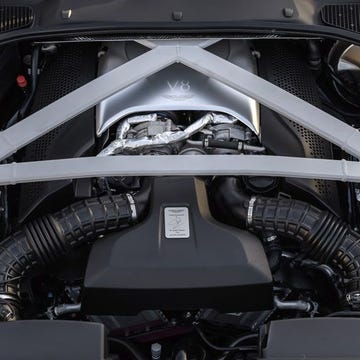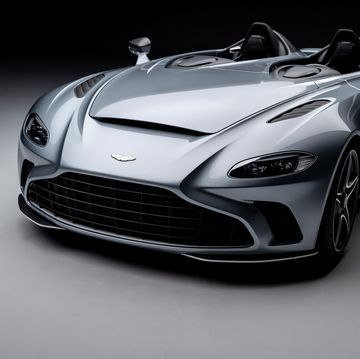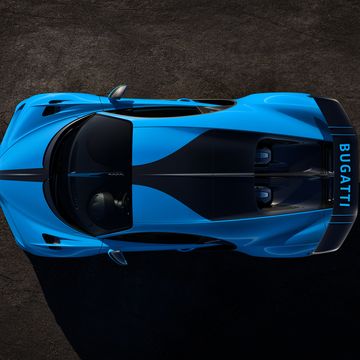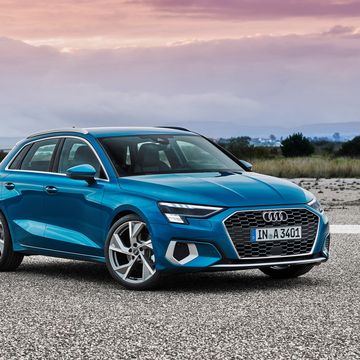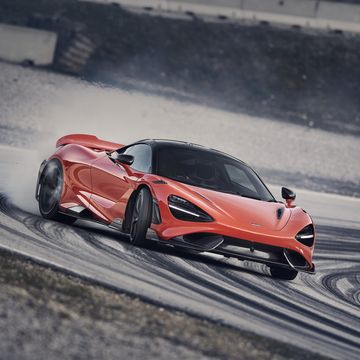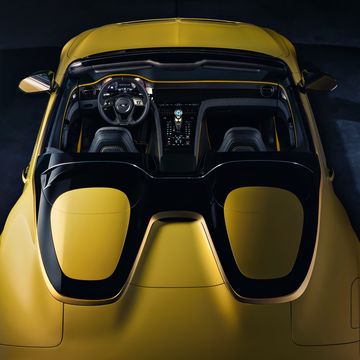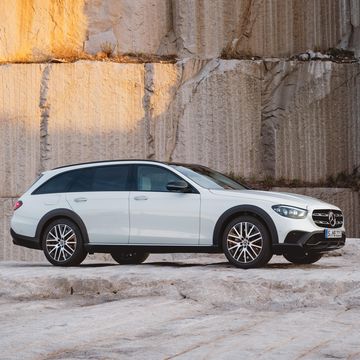From the February 2015 issue of Car and Driver
A 640-hp Nürburgring-eating CTS-V isn’t a natural descendant of the house of Cadillac. The king of cush and the caesar of geezers was once none too concerned with steering fidelity, roll gradients, lateral grip, and the like. These were figuratively and literally foreign concepts, as the modern luxury car—as sharp at clipping an apex as it is comfortable on the highway—is largely a European conceit.
Cadillac finally turned a corner (without hideous squealing) in 2003 with its first CTS. Ever since then, the brand has been hellbent on topping its German rivals. The 2016 CTS-V, which made its debut at this year’s Detroit auto show, is Cadillac’s best chance yet to do so.
We’ve already witnessed the third-generation CTS top the Mercedes-Benz E-class and the BMW 5-series (albeit while taking second place to the Audi A6). Starting from the same cornerstone, the new CTS-V should have Germany’s three big gunslingers—Audi RS, BMW M, and Mercedes-AMG—reaching nervously for their lederhosen.
The CTS-V has always been a kind of four-door Chevy Corvette. The new V ties the Vette connection even tighter with an engine lifted from the ballistic Corvette Z06. The engine is so lightly altered for Cadillac duty that the company could have called this car the CTS-V06.
The 6.2-liter supercharged V-8 retains the LT4 moniker and packs the Z06’s forged aluminum pistons, powder-metal forged connecting rods, titanium intake valves, and an Eaton blower pushing 1.7 liters of air per rotation. Aside from the intake and exhaust arrangements, the major difference between the Corvette and CTS-V engines is the lubrication system. In the Corvette, the low hood and the height of the supercharger dictate a dry sump and remote oil reservoir. The relatively tall Cadillac doesn’t have the same hood-height issues, so oil starvation is kept at bay in high-g corners by a deep sump, reducing complexity and weight.
Given the differences in their cooling systems and how the two cars breathe (plus the always-lurking horsepower hierarchy dictated by brand management), all of the Z06’s 650 horsepower and 650 pound-feet of torque won't materialize in the Cadillac. Instead, the CTS-V is rated at 640 horsepower and 630 pound-feet. We project a zero-to-60 blitz of 3.7 seconds en route to a 12.0-second quarter-mile ET. Those figures would essentially match the BMW M5’s, but lag behind those of the four-wheel-drive Mercedes-Benz E63 AMG and Audi RS7 by a quarter to half of a second.
The V’s top speed stands to be even more impressive. CTS chief engineer Tony Roma was coy at first, saying only that his team aims for “a big number,” but he eventually let on that they’re hoping the car will exceed 200 mph. At our interview, the closest we got to a CTS-V in motion was firing the small-block V-8 engine. Its eight cylinders came to life with a rabid bark that ricocheted off the coved walls of our photo studio before the 6.2-liter settled into a gravelly idle, fast and loud. The sound is as awesome as it is assertive, though your neighbors may think otherwise when you leave the driveway at 6 a.m. For those occasions, you’ll want to start the car in tour mode, which keeps the muffler-bypass valves closed to quiet the snarl.
GM’s own 8L90 eight-speed automatic is the sole transmission, a move that disappoints but in no way surprises us. Roma offers a conciliatory maybe: “If there’s enough fervor from the enthusiast community, we’ll consider doing a manual.” Don’t hold your breath. With the forthcoming ATS-V to go toe-to-toe with the BMW M3, the CTS-V now assumes a narrower role. There will be no coupe or wagon, and the price swells from $65,825 for the 2014 CTS-V sedan to roughly $85,000.
The chassis follows the usual formula for making sedans sportier, including stiffer springs, larger anti-roll bars, and firmer bushings. In the front suspension, using two lower links instead of one control arm quickens steering response. Magnetorheological dampers are standard, as is an electronically controlled limited-slip differential borrowed from the CTS Vsport and modified with a heat exchanger connected to the transmission’s cooling circuit.
Iron brake discs mounted on aluminum hats measure 15.4 inches up front and 14.4 in the rear. They’re squeezed by six- and four-piston calipers, respectively, borrowed from the Camaro Z/28’s carbon-ceramic brake package. The rear discs are so large, they’d be verboten in the World Challenge series where the current CTS-V coupe competes. The brakes surely won’t shed heat quite like carbon discs, but the added surface area of the massive rotors means the front discs run 200 degrees Fahrenheit cooler while working than those of the outgoing car.
Michelin tailored the Pilot Super Sport tires—265/35-19 front and 295/30-19 rear—specifically for the car, and the tires come out of their own bespoke mold. Two different tread rubber compounds balance the contradictory goals of extending tire life and maximizing cornering grip.
The CTS-V is one car with one suspension. There are no upgrades, no optional big wheels, and no add-on carbon-ceramic brakes. The only chassis-related choice comes down to wheel finish. “These cars are meant to be the boutique offering,” Roma explains. “We feel like good is good, so we’ve tuned the chassis and you get the good stuff. You don’t have to check the track-package box. This is the track package.”
Those who do venture onto road circuits will benefit from the CTS-V’s first use of the Performance Traction Management (PTM) system. First demonstrated on the 2010 Corvette ZR1 and now offered on all Corvettes, PTM’s five modes—from wet to race—progressively loosen the stability-control system’s oversight. Track rats also can record their exploits on the optional Performance Data Recorder, which overlays vehicle data on a video captured by a camera mounted ahead of the rearview mirror.
If the CTS Vsport is any indication, the full-blown V should deliver some of the purest steering feel out there—not just among the competition, but in all of luxuryland. For the Cadillac team, it’s a product of philosophy more than an engineering challenge. “If you look at the fundamental parts that a lot of our competitors have in their cars, you’ll find architectural components that you would put in a car to get what I call good steering feel,” Roma says. “So when we go drive the resulting car, a lot of times we go, ‘Whoa, this is so isolated.’ Clearly a lot of our competitors favor ride and isolation because there is a trade-off to be made.”
The CTS lineup benefits from an electric power-steering motor that connects to the rack via a belt rather than a gear or a recirculating-ball system. When the car passes over a pavement imperfection, there’s enough compliance in the belt for the jostle at the tires to reach the steering wheel without being damped out by the assist motor’s inertia. In the V, the steering supposedly becomes even more direct when the PTM system is set to its highest levels, switching off the electric power steering’s damping and self-centering functions.
The V series looks the part of a factory-tuned street racer with a louvered hole punched in the carbon-fiber hood, wider front fenders, and a slightly lower stance. The fender vents, originally requested by the design team, were only approved on the condition that they be functional. While they aren’t critically important, the vents do connect to the engine bay, providing an escape for underhood heat. The car we photographed wears the optional carbon-fiber package with a longer front splitter, a taller spoiler, a carbon rear diffuser, and Gurney flaps ahead of the front wheel wells. The package doesn’t reduce weight by any quantifiable measure, but it does reduce aerodynamic lift, aiding the CTS-V’s high-speed handling balance. Unfortunately, the additional downforce imposes higher drag, so cars equipped with this option aren’t likely to reach 200 mph. While the exposed weave gives this $85,000 Cadillac a we-made-it-for-SEMA vibe, the quality at least lives up to the price. Look closely and you’ll see that the carbon fiber is laid at an angle and book-matched so that the weave creates a “V” at the center of the car. Whether you order the carbon package or not, the CTS-V comes with a new curb-view video system that uses two downward-facing cameras mounted along the upper edge of the lower grille to help drivers nestle up to a curb without scrunching the lower fascia. It’s a useful feature that should be shared with the Corvette team in exchange for its LT4 V-8.
The V-specific weight-saving measures are few and limited, but the Alpha platform on which the CTS is based has a lean bone structure to start with. Cadillac claims a weight of 4145 pounds for the CTS-V, a drop of roughly 100 pounds from the previous car. And while 4150 pounds isn’t light, it is less than the 4300-pound M5, the 4400-pound E63 AMG, and the 4500-pound RS7.
Less weight is one advantage Cadillac has never held in previous comparisons. We’ll soon know if the claim holds up, and more importantly, if Cadillac’s long-running pursuit of Germany’s ultimate sports sedans has finally paid off.
| Specifications | |
| Vehicle Type | front-engine, rear-wheel-drive, 5-passenger, 4-door sedan |
| Base Price (est) | $85,000 |
| Engine Type | supercharged and intercooled pushrod 16-valve V-8, aluminum block and heads, direct fuel injection |
| Displacement | 376 cu in (6162 cc) |
| Power HP @ RPM | 640 @ 6400 |
| Torque LB-FT @ RPM | 630 @ 3600 |
| Transmission | 8-speed automatic with manual shifting mode |
| Dimensions | |
| Wheelbase | 114.6 inches |
| Length | 197.6 inches |
| Width | 72.2 inches |
| Height | 57.2 inches |
| Curb Weight (C/D est) | 4200 lb |
| Performance (C/D EST) | |
| 0–60 mph | 3.7 sec |
| 0–100 mph | 8.5 sec |
| Standing 1/4-Mile | 12.0 sec |
| Top Speed | 190–200 mph |
| Projected Fuel Economy (C/D EST) | |
| EPA City/HWY | 14/22 mpg |

Eric Tingwall holds degrees in mechanical engineering and journalism, a combination he pursued with the dream of working at Car and Driver. While living his dream, he has cut car parts in half, driven into a stationary dummy car at 50 mph, lapped Virginia International Raceway in the hottest performance cars, and explained the physics behind the wacky, waving, inflatable, flailing-arm tube man.
